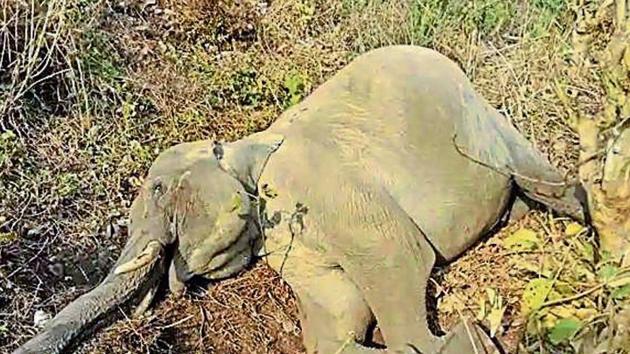Mysterious death of tusker in Corbett tiger reserve raises questions
This has raised a question as to why the patrolling staff couldn’t spot the carcass of such a big animal in the national park. Also, it is not yet clear how the elephant died and what was its exact age.
The death of an elephant under mysterious conditions in Corbett tiger reserve’s Kalagarh range has raised many questions.

The officials are saying the carcass of the tusker found on Saturday was around one month old as much of its body has been eaten by tigers and other wild animals.
This has raised a question as to why the patrolling staff couldn’t spot the carcass of such a big animal in the national park. Also, it is not yet clear how the elephant died and what was its exact age.
RK Bhatt, ranger Kalagarh range, said the thing is that though the elephant was a big animal, it decays fast and when left in the forest, it is eaten by tigers and other wild animals.
On why the staff couldn’t spot such a huge animal during its routine patrolling, Bhatt said staff generally patrols the forest areas through the jungle pathways.
“Sometimes if the wild animal has died deep in the interior or some remote location, it is not spotted that easily. We have a field staff of over 80 in Kalagarh range, but this time the site at which it died-Bada Srot in Khatpani area of Kalagarh-was little away from the routine patrolling path,” he said.
Bhatt said the skeletal remains of the tusker have been taken as evidence to ascertain the causes of its death.
“It is not yet clear whether it died due to tiger or tigers attacking, or whether it fell from a hillside,” he said.
Shivraj Chand, warden Corbett tiger reserve, said as both tiger and elephant numbers were increasing in Corbett, they have on a regular basis requisitioned for an increase in patrolling staff from regular 300 to 600 members.
“We need more patrolling staff for effective monitoring. Though we employ daily wagers, they are not that well trained, experienced or serious,” he said.
He added that as the place where the elephant was found was remote, it was found nearly after a month, with flesh left only around its feet. “The area has good tiger presence and they have eaten much of its flesh,” he said.
The death of two elephants died in the Corbett Tiger Reserve in four days and many others in the last two years, has put a spotlight on the overall safety of the pachyderms in the Corbett landscape.
Elephants have died due to varied reasons ranging from tiger attacks, falling from hills to electrocution.
In April 2017, an elephant was electrocuted by a high-power electric line in Ramnagar forests near Corbett. In November 2016, an elephant was killed due to electrocution in Kalagarh area of Corbett.
Harendra Singh Bargali, deputy director The Corbett Foundation, said generally when a big animal like elephant dies, the birds and vultures keep flying around it and there was a commotion in that part of the jungle.
“If the staff had been near, they could have read these signs and spotted the carcass. But it also depends on the exact terrain where the elephant has died. If it has fallen from a cliff into a narrow stream or a valley, it may remain unseen for a long time. Three years ago, an elephant had fallen from a cliff into a nallah in Corbett. I had gone there, but that time it was spotted within three to four days”, he said.
Bargali said amid the reports that the population of tuskers has increased in Corbett landscape, the patrolling and safety mechanisms for the pachyderms also need to be increased and strengthened.
According to Wild Elephant Population estimation carried out in 2015 by the forest department, Uttarakhand has 1,797 elephants, with Corbett landscape emerging as the main bastion of elephants in the state with as many as 1,035 elephants recorded, 242 of them in Dhikala range alone.




